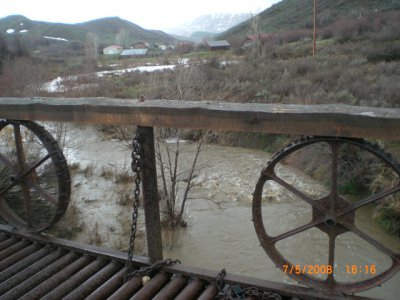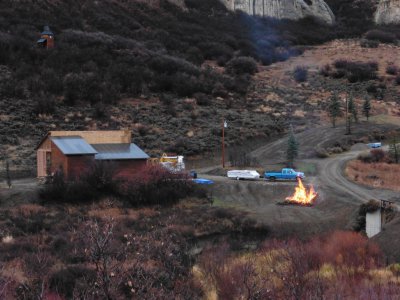OK I just picked up a Miller Thunderbolt AC/DC SMAW manufactured between July 2000 and Dec 2000 from a nice guy on craiglist for $200. Machine is in good shape. He struck it up before I bought it. It definitely melts metal. I have a few questions for you guys:
1. First things first. SMAW is bright! A few years ago I bought a Miller Titanium 9400i with grinding shield (1st gen. without info. track) because my eyes are important to me. I just read the reviews and can agree with all the negative comments. But here is the deal, when we tried out the Thunderbolt this morning I cranked up the shade to 13 and it was still not dark enough. Am I doing something wrong? I am considering buying a low number passive lens and sticking it inside where the magnifying glass goes. This is how I want to see, at min. 4:22
Edit: Local Airgas dealer put two new batteries in my helmet at $5 each and says it is good to go. He said the Duracell which I put in about two years ago are not as good as the Miller branded batteries. We shall see.
2. What would be the best electrode, polarity and amperage for welding 1/4" steel to 1/4" steel. The machine has two amperages for AC and also a choice between DCEN or DCEP.
3. What would be the best electrode, polarity and amperage for welding 1/2" bar stock to 1/4" angle? Assuming DCEP (direct current electrode positive) which apparently is best for deep penetration on thick metals, what would be the best electrode for 1/2" steel? On another thread
chuck suggested: "I would use a 6010 and finish out with lincoln 7018,s one with a D designation" If so, what diameter 6010 electrode? What polarity? What amperage?
In my recent reading about SMAW, the following statements seemed helpful. Any suggestions, changes, comments?
"One way to look at the polarity issue is by the welding rods that are available to you. 6010 runs DC+ only. 6011, which is similar to 6010 (forceful arc, deep penetration, light slag) runs best on AC, but runs all right DC+. 6012 runs best DC-, not good at all DC+. 7018 runs DC+ up to about 300 amps, better on AC above that. 6013 runs well either AC or DC+ for general welding, but was developed for high speed sheet metal work on DC-. And so forth.
The trouble with that approach is that it goes at the issue backward.
What's important is matching the electrode (rod) to the job first, then running it on its best polarity after that. You would rarely match the polarity to the job first, and the rod to the polarity second---with two main exceptions: If you are having a problem with arc blow (the arc wanders off course because of the magnetic field caused by the location of the ground, or some other magnetic field disturbance) which you can't resolve by moving the ground clamp, you can turn to AC, which is not subject to arc blow. The other situation where polarity would be a primary consideration is when you know you need more of the heat in the work than in the rod. DC- provides 2/3 of the heat to the work, DC+ provides 2/3 of the heat to the electrode, and AC is 50/50. 6012 and 6013 electrodes were both originally developed for high speed sheet metal work on DC-, so that would be an example of a time to choose that polarity. I don't do much sheet metal work with stick, high speed or any other way, so I couldn't say. I do know that 6012 running DC- is unusually good at filling gaps in bad fitups, but 6010 is good for that too, and there's not as much slag to entrap with 6010.
DC is generally considered to strike an arc easier and stay lit better than AC, but if any electrode strikes easier or stays lit better than 6013 running AC (or DC, to be fair) I haven't run across it.
There are some real differences between the three polarities in stick welding, but they're not so profound that an inexperienced operator would even necessarily notice them. If your son gets to the point where he can tell just when to use one polarity rather than another, or even just how high to set the current, before he's burned ten thousand sticks, then he's got a real gift and maybe he should look into something that pays better.
All the best, Stan"
"Welding is a process of heating the base metal to where it can accept drolets of molten metal from the electrode to join metal.
AC, DCEN and DCEP are used to control those droplets of molten metal.
The flow of electrons in DC welding circuits is from negitive to positive and is called straight polarity.
When we reverse the welding leads then electron flow is from positive to negitive also called reverse polarity.
When AC current is used for welding, you get a base metal cleaning action that cleans on the alternating phase of the current, anotherwords the current cylces up and down thru the frequency and the base metal is cleaned and filler metal is deposited in both directions. This works well in the flat position and when the base metal hasn't been prep'd as it should be and where the molten droplets has a chance too fast freeze to the base metal.
When DCEN is used for welding the most of the cleaning action stops as far as the frequency is concerned as DC current only flows along the surface of a line and doesn't alternate thru the base metal like the AC current did.
Since electron flow is from negitive to positive then the molten droplets flow too the base metal from the electrode causing a very fast deposit of the droplets. The slang term is known as fast freeze between weldors. If the droplets fast freeze to the base metal then the base metal is cooler while welding thus is a good choice for sheet metal welding or filling poor joint fit up.
When DCEP is used for welding electron flow is from base metal to the electrode and most of the heat build up is on the base metal. What this does is allows for greater molten puddle control for the weldor when using the correct electrodes. Transfer of the molten droplets is slightly slower than using DCEN or AC.
This will cover the basics of some of the differences but in reality there's alot more to using AC, DCEN or DCEP than what's been written here, so I will add too this at a latter time.
T_Bone"
from:
http://www.yesterdaystractors.com/cgi-bin/viewit.cgi?bd=toolt&th=176652
This is what it says on the Thunderbolt spec sheet:

 Mike
Mike
